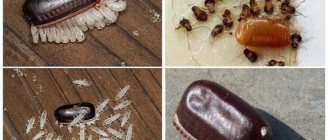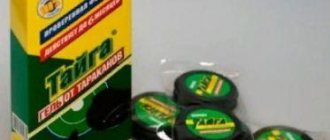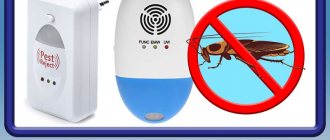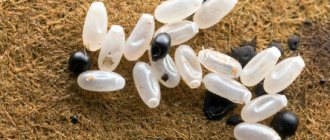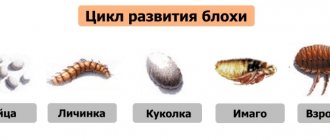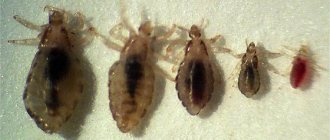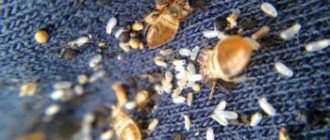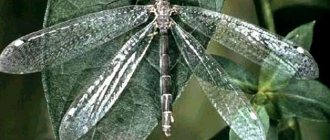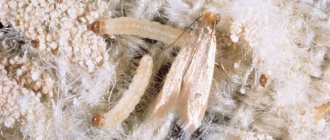When cockroaches are discovered in a home, everyone probably immediately thoroughly disinfects the premises, which allows them to temporarily get rid of the problem. As a rule, insects reappear some time after treatment.
Most often, this situation is caused by the presence of clutches of cockroach eggs in the secluded corners of the apartment, which even the most effective pest control agents cannot cope with the destruction of.
Insects reproduce quickly; just a few adults are enough to revive a colony in a couple of months.
What should you know about the offspring of cockroaches in order to protect your home from uninvited guests? What do cockroach eggs look like, what measures should be taken to destroy them? Let's consider these questions in more detail.
Eggs and their capsules (oothecae)
After insect oocytes are fertilized by sperm, they go through a series of gradual stages.
At the end, small eggs appear, from which new individuals hatch in the future. However, this process is not instantaneous. The eggs still need to mature. For this purpose, a special capsule is formed in the female’s body - ootheca. It is a fairly rigid “bag” that performs a number of important functions:
- Reservoir for eggs. One ootheca can contain up to 50 small future cockroaches.
- Protective. Thanks to the hard shell in such a capsule, the eggs are not afraid of temperature changes and the effects of insecticides.
- Nutritious. Embryos develop inside the eggs, having a certain supply of necessary substances. Only after they are exhausted does the process of young individuals emerge.
Ootecae come in different sizes. It all depends on the type of particular insect. On average, it is 8-12 mm long and 4-6 mm wide. The eggs in it are “packed” into tight 4 rows - two in height and the same in width. Most often, such a capsule protrudes slightly from the female’s abdomen and creates the appearance that she is “pregnant.” Some species (black cockroach) leave their “bag” to the mercy of fate. Other (Madagascar) representatives of this group of insects carry clutches constantly in the abdomen.
Over the course of her entire life, the female lays on average up to 4-5 oothecae. Sometimes this figure rises to 9, and the total number of young representatives of the genus is 250 individuals.
About the reproduction of cockroaches
Do cockroaches lay eggs? Yes they do. In fact, they "lay" many eggs at the same time. Like many animals, the cockroach's reproduction depends on eggs from the female and sperm from the male. Typically the female releases pheromones to attract a male, and in some species males fight over available females. But what happens after a male deposits his sperm into a female varies from species to species.
After mating, female cockroaches lay their eggs in a secure oval capsule called an ootheca. When the eggs are almost ready to hatch, the mother of most species either drops it near a food source or uses oral secretions to stick it to a suitable surface.
How does boric acid kill cockroaches?
The venom from cockroaches affects them upon contact. The substance penetrates through the outer layers and when used internally. Microscopic crystals stick to the whiskers and paws when the cockroach touches the bait. He is cut off by the sharp edges of the crystals and receives wounds that will not heal.
Boric alcohol penetrates the internal organs of the insect in large quantities. Moisture evaporates from the body, dehydration occurs, and the insect dies. On the other hand, boron manifests itself as an insecticide; boric acid causes permanent injuries in the functioning of all organs, affects their structure, and causes blindness. The insect is disoriented in space, paralysis occurs. This causes slow but inevitable death. The problem is to get cockroaches to try the product prepared for them, and there is already a question of technology.
When cockroaches run over boric acid powder, the crystals stick to their feet, etc. When the cockroach tries to clean itself, it ingests the powder.
If the cockroach does not clean itself, its body will still absorb the powder. Once the acid penetrates the cockroach, it enters the nervous and digestive systems, causing death shortly after ingestion.
The remedy is also considered effective because cockroaches eat other dead cockroaches. As most of us know, cockroaches are not picky about what they eat. After the cockroaches have eaten a fellow poisoned with boric acid, the acid enters their body, and the cycle of poisoning continues.
Curious facts
Those who like to kill cockroaches in a sudden way should be aware of the extreme resistance of such insects to physical damage. Therefore, swatting it down is not enough; you also need to either grind it thoroughly, or sprinkle it with boric acid while still half-dead and release it to its relatives.
Interesting information: thanks to a specific gene, called “knockdown” by scientists, cockroaches can imitate their own death. Smelling the smell of poison, the insect loses consciousness, falls with its paws up and stops breathing.
After lying down for a certain period, he comes to his senses and calmly continues his sabotage activities.
https://protarakanov.ru/skolko-tarakanov-vyiluplyaetsya-iz-odnogo-yaytsa.html https://tripchik.ru/tarakany/yajca-tarakanov.html
How to deal with cockroach eggs?
Taking into account the characteristics of the reproduction and development of cockroaches, it is possible to determine an effective strategy for combating insects:
- It is worth making every effort to ensure that females with ootecae leave your apartment in search of more favorable places for their offspring. To do this, it is necessary to destroy potential places of their settlement - seal the cracks, change old wallpaper and tiles, close the ventilation ducts with small grilles. What cockroaches don't like most is a clean home, where there is no overflowing trash can, dirty dishes in the sink, and all food items are securely packaged and closed.
- If cockroaches live in your neighbors’ apartment or entrance, then preventive treatments should be carried out with gels and crayons, and poisonous and glue traps should be laid out. This will eliminate the adults that have entered your home. Thus, an entire colony will not reproduce in it.
- If cockroaches appear, you can treat the room with aerosols. The insects quickly die from suffocation - the females do not have time to hide in a secluded place to shed the oocyte.
- The eggs of these insects are not afraid of chemical agents, but are not resistant to mechanical methods. Regular ventilation of the room with frosty air can be fatal for egg laying. If possible, you should vacuum all possible breeding sites for cockroaches using special narrow nozzles. The most effective remedy is to expose the masonry to hot steam from a steam cleaner. Powerful floor units used by teams of exterminators are suitable for this.
- You cannot limit yourself to one treatment of an apartment; 3 to 4 treatments carried out at regular intervals will allow you to destroy the nymphs that have hatched from the eggs.
So, when fighting cockroaches, do not forget about their oviposition, which also needs to be eliminated in order to rid your home of unpleasant insects.
Can cockroaches be called viviparous?
Despite some features of the appearance of larvae from the cavity of cockroaches, they cannot be classified as viviparous. It is more correct to call them “oviparous” or “ovoviviparous”.
In the first case, the female cockroach leaves the ootheca in a closed place, and the offspring develop on their own. In the second, the ootheca is located in the body cavity of the female individual until the very moment the larvae hatch into the world.
It follows that cockroaches can be designated with the words “pregnant” or “viviparous” only conditionally; from a physiological point of view, in reality there is no such thing. In addition, the term “birth” is also not entirely correct to use when talking about these insects. It would be more correct to say “birth”.
About the independence of newborns
From the eggs, nymphs (larvae of cockroaches) are born, differing from adults only in size, color of chitinous integument and inability to reproduce. As they grow older, young cockroaches molt several times, constantly increasing in size.
Cockroach nymphs emerge from the ooteca
Nymphs emerging from eggs are often white in color, which has led to the belief that there is a special species of white cockroaches. However, like other animals, there are albino cockroaches who retain this color throughout their lives, since their body is not capable of producing pigment.
Depending on the species, cockroaches take care of their eggs differently:
- Blacks shed their edema 3-4 days before the young insects hatch and do not care about it at this time. This is precisely the reason for the decline in their numbers - the ubiquitous red cockroaches and ants find ownerless oothecae and eat them.
- Red cockroaches demonstrate the wonders of parental care. They not only free themselves from the cocoon immediately before the offspring emerge from it, but also guard it for several hours.
- Nymphs of Madagascar cockroaches even hatch inside the female’s body, since she sheds the ooteca already when the babies hatch and become independent. In case of danger, she takes it with her. Because of this feature, they are sometimes called viviparous, although in fact they are not.
Newborn nymphs spend some time under the constant supervision of adult females. This is due to the fact that immediately after birth their chitinous shell is soft, there is no immunity, and mobility is limited. This care continues for about two weeks until they become stronger and can feed themselves. For some time, the young cockroaches do not go far from the nest. During their entire existence, nymphs molt 5-6 times, after which they turn into adult insects and begin to reproduce.
What is the difference between these groups
In all species of cockroaches, the development of offspring to the larval stage occurs in a capsule - the ooteca. But in ovoviviparous animals it is hidden in the female’s body. When the time comes, ready-made larvae emerge from the cockroaches. It may seem that such species are viviparous, but they are not. Development proceeds standardly: the first stage is the egg.
In oviparous animals, the ootheca gradually moves out of the abdomen as it fills. Eggs fill the capsule 4 in one row: 2 high and 2 wide. Domestic cockroaches belong to the second group.
Interesting!
The literal translation of the word “ootheca” from Greek is the storage of eggs.
Oviparous species are also divided into 2 groups. Some carry the ootheca with them until the young hatch. Others drop the “container” as it fills.
Possible locations of the ootheca
The presence of cockroaches in apartment buildings has remained a problem for many years. These insects have become so adapted to human habitation that they successfully find safe places to breed:
- in ventilation compartments;
- in the cracks behind the baseboard;
- in the cracks present between parts of furniture;
- under washbasins, sinks, cabinets, beds;
- in utility rooms and storage rooms.
When cleaning an apartment, you come across dry shells of insect capsules. They must be taken out of the apartment to the trash can. If an ootheca of cockroaches is found, then it must be destroyed - there is a risk of the birth of a large number of pests.
Fighting cockroach populations on your own is a thankless task, because it is ineffective. The best way to get rid of it is to call a pest control service.
Preventive measures
As preventive measures against the spread of cockroaches in the home, it is recommended to use the following recommendations:
- Maintain perfect cleanliness in the kitchen and in the apartment as a whole. There should be no crumbs on the tables and floors, and greasy deposits on the walls. The trash can should be taken out in a timely manner, without putting it off until tomorrow.
How to get rid of cockroaches at home
It is rare to find an adult who has not seen red cockroaches in everyday life. If he did not have these nimble mustaches in his house, then they were found in institutions, catering establishments, hostels, and low-class hotels.
Red cockroaches are often called cockroaches; they are very interesting insects. Prussians have very developed antennae. Thanks to this, the insect smells and communicates with other individuals. When an antenna is injured or lost, the pest does not receive enough information. Favorable home conditions with a temperature of +20 degrees contribute to the annual lifespan of the red pest. During this period, the female lays a huge number of eggs, which contributes to the expansion of the population.
How to get rid of pet cockroaches at home
Due to the fact that the home conditions of an apartment with heat, water and food contribute to the expansion of the offspring of domestic Prussians, getting rid of them is not so easy. When the population of these harmful insects has not yet expanded, preventive measures that do not have a chemical basis should be carried out. Such means include:
- laying out branches of strong-smelling plants around the apartment: St. John's wort, mint, wormwood, tansy, chamomile;
- washing floors with the addition of a decoction of bay leaves, ammonia, bleach, essential oils;
- paint, kerosene, denatured alcohol, turpentine;
- forming and laying balls of egg yolk and boric acid around the apartment;
- installation of drinking bowls for the Prussians, consisting of water with boric acid;
- installation of various traps in which the Prussians will drown or stick.
Red cockroaches in the apartment: how to get rid of them - ways and means
Due to the fact that residents have long been tired of red Prussians, all sorts of methods are used to combat them. Some apartment owners, when leaving their home, leave them without water. To do this, cover the kitchen sink with a towel so that insects cannot get the required source.
An effective way to get rid of cockroaches in an apartment is considered to be a do-it-yourself trap made from a packet of yogurt, kefir, or fermented baked milk. This product needs to be eaten, and the Prussians should only be left with paper packaging with food residue on the walls. Insects will crawl to the smell, but will not be able to stay on the walls of the bag, falling into the water with which the container will be filled.
Red pests do not tolerate boric acid. An effective folk method is to form balls from boiled egg yolk, mashed potatoes and boric acid. Such balls must be placed near the baseboards. You can also place drinking bowls of water with boric acid around the apartment. You can sprinkle boric acid in places where these insects accumulate.
If simple remedies do not help, they turn to more serious methods of chemical exposure. These include various sprays, gels, powders, and crayons.
The best remedies for cockroaches in the apartment
At any time, in different household conditions, different means of combating red Prussians are used. For some rooms, “Mashenka” crayons will be sufficient, but in other conditions more effective methods will be required:
- gels “Global”, “Raptor”, “Rubit” “Dohloks”, “Brownie” “Kombat”, “Kapkan”, “Absolute”;
- aerosol “Combat”, “Raid”, “Clean House”, “Raptor”, “Dichlorvos”, “Executioner”, “Regent”, “Karbofos”, “Mashenka”, “FAS”, “Get”, “Cucaracha”.
Fighting red cockroaches with sprays leads to an instant effect. But this drug does not affect eggs. Gels work well. The insect that received the dose of the drug will die. But it will bring poison into its hole, infecting other members of the family. This method of getting rid of pests leads to the destruction of red Prussians, as they eat their dead relatives.
What are cockroaches afraid of in an apartment?
It has been established that cockroaches in the apartment are afraid of strong odors. They don't like:
- aromatic essential oils, kerosene, denatured alcohol, ammonia, oil or nitro paint, bleach;
- St. John's wort, wormwood, tansy, mint, chamomile.
Folk remedies for cockroaches that are harmless to humans, the smells of which cockroaches do not like, lead to their expulsion from the apartment. Therefore, do not neglect such simple prevention methods that will allow you to get rid of a possible problem.
To get rid of Prussians for a long time, it is necessary to destroy existing insects and prevent the appearance of new ones. Any methods that do not harm humans are good for this. Pleasant reviews from consumers are addressed to modern gels: “Absolute”, “Combat”, “Raptor”. Aerosol cans of the brands “Raid”, “Dichlorvos”, “Regent” remain always popular.
Traditional methods of pest control
For those who are afraid to use store-bought chemicals, folk methods will come to the rescue. It turns out that cockroach larvae and adult insects cannot tolerate common chamomile flowers. It is recommended to grind the plant to a powder and scatter it around the apartment.
A more radical method would be to freeze the apartment. Cockroaches die at temperatures below -5 degrees.
In addition, pests have a developed sense of smell. They cannot stand the smell of gasoline and ammonia. You can coat baseboards and corners with flammable liquid. And wash the floors with ammonia.
Red pests
In our latitudes, red cockroaches are most often found - Prussians. Although initially these are tropical insects. They even have wings. The good news is that mustachioed pests do not fly. At most, they can balance with their help when falling from a height.
The larva of the red cockroach also has wings and whiskers. By the way, it is the mustache that allows insects to receive information about the outside world. Having damaged this tactile organ, the insect will not be able to live fully.
Adults usually grow to 1-1.5 centimeters in length. Nymphs, accordingly, are even smaller in size. It is their miniature size that allows the “barbels” to quickly hide from human eyes. Skirting boards, cracks in the wall, ventilation, and the space under the stove are ideal places for red pests.
Like the adult, the larva of the domestic cockroach feeds on leftover food, bread and sugar crumbs. During the day, the insect “sits out” in the shelter, and goes out to “hunt” at night.
Currently, red cockroaches are common on all continents. The main condition for their survival is above-zero temperatures.
What happens if you accidentally eat a cockroach larva?
There are times when people call or write to us and ask in a voice with a slight tinge of panic what will happen if they accidentally eat a cockroach larva. Apparently, someone had a similar incident, a child could eat a piece of cookies with a small nymph, or the person himself did it.
Most likely, in this case nothing bad will happen. There is a chance that you will receive some portion of microbes, but you will not swallow anything fatal. So don't worry. But such situations themselves are very eloquent. That is, there is a possibility that a cockroach, which yesterday collected bacteria in the basement, is running through your products today.
Also keep in mind that any chocolate contains the remains of cockroaches in varying quantities. Not ours, of course, but tropical ones, but the difference is small - according to scientists, about half of the cases of chocolate allergy are, in fact, associated with an allergy to the remains of the bodies of cockroaches ground together with cocoa beans.
Therefore, one cockroach that someone accidentally ate with cookies or bread is nothing compared to the number of cockroaches that we constantly eat with chocolate.
Features of the appearance of larvae
Quite interesting is the fact that some pests demonstrate a certain maternal instinct towards their offspring. When cockroaches hatch from the eggs of a Madagascan representative, they crawl under the mother’s abdomen and remain under her direct protection for some time. The female hisses and makes threatening lunges when potential danger approaches. However, such care is only enough for 1 day.
Classic Prussians practically do not care for their young. The offspring simply stays near the female for a few more hours, after which they scatter to secluded corners.
One of the interesting exceptions remains the species of relict cockroaches. In their case, after the “birth” of young individuals, they are looked after and provided with food. Upon reaching a certain degree of maturity, new members of society take their assigned place in the hierarchy of the colony. In this case, it is somewhat reminiscent of a termite mound with different ranks and its own complex hierarchy.
Black cockroaches in the kitchen
Black cockroaches are much less common in residential areas. They are also called American or kitchen.
These insects are almost twice the size of Prussians. They are also distinguished by their charcoal color. The black cockroach larva is also larger than the red nymph.
"Americans" also have small wings. Juveniles and females do not use them. Males, in turn, have fairly long wings, which help them jump long distances.
It is believed that black cockroaches are easier to kill than black cockroaches. When females lay eggs, they leave their offspring unattended. After two weeks, larvae should emerge from the clutch. If during this time the eggs are found by other types of cockroaches, they will feast on their “relatives”.
By the way, black insects, like red ones, prefer to breed indoors. Although they may well live in nature. The main thing is that the temperature does not drop below 0 degrees.
How to get rid of cockroach eggs forever?
Knowing how many cockroaches are in one egg is important not only for interest, but also for destruction. Since cockroaches reproduce quickly, a full-fledged colony is formed within a few months. And if the conditions are favorable for development, then one month is enough
Destruction with such representatives usually looks like military action. Especially if a person cannot decide on his own how to remove the animal from the house
And if the conditions are favorable for development, then one month is enough. Destruction with such representatives usually looks like military action. Especially if a person cannot decide on his own how to remove the animal from the house.
There are three options:
- calling services. This service is provided in any city by special enterprises. This is convenient because the owners will only have to clean the premises after visiting specialists. This means collecting destroyed parasites. Of course, you will also need to prepare at home before starting the procedure;
- folk method. There are many recipes here. The main thing is to choose an effective and powerful one. If the insects have just appeared, then egg and borax balls will do. If the parasites have already multiplied, then in addition to the balls you will have to use herbs and other plants and substances;
- chemicals. This group includes gels, traps and aerosols. Their use always gives results faster than traditional recipes.
But it is worth noting that more than one species cannot remove cockroach eggs from the house. Chemicals used by industrial disinfectants have the greatest impact on eggs.
How many larvae should I expect from one insect?
People say: “If you saw one cockroach, that means there are at least ten of them.” It is the rapid proliferation of mustachioed pests that is frightening. To understand the scale of the problem, you need to know the answer to the question: how many larvae does a cockroach lay?
It is impossible to calculate the exact amount. At an average level of life, the number of nymphs in a clutch will correspond to the number of eggs. If the female thinks that the conditions for procreation are unfavorable, then she discards the capsules with offspring in advance.
At good temperature and sufficient nutrition, several insect larvae can mature in the egg. In addition, cockroaches are able to regulate the number of offspring themselves.
The number of clutches depends on the type of insect:
- Prussians lay 25-50 eggs at a time, and during their life they are able to leave offspring up to 12 times.
- Black cockroaches break off almost 2 times fewer eggs - 12-18, but during their life they leave 22 clutches.
The most dangerous insect is a pregnant female pest. Dying herself, she manages to discard eggs, which are almost impossible to destroy. Another sad fact is that the cockroach larva is born as an independent individual. Thus, the fight against kitchen saboteurs turns into an endless marathon.
The process of “birth” of cockroaches
If how cockroaches hatch from an egg remains less clear, then the question of the timing of this process remains open. The fact is that a lot depends on environmental conditions. Thus, a new generation of insects is born most quickly at high temperatures (+30°C) and humidity levels. At the same time, when the temperature changes to +15°C and below, a slowdown in metabolic processes is observed, and the “birth” of offspring is postponed.
For those who don't know how long it takes for cockroach eggs to hatch, the average answer is 30-75 days. It all depends on the specific type of insect and the conditions in which small individuals develop.
It is also important to know that absolutely all types of pests lay eggs. Sometimes when observing a female Madagascar cockroach, you may mistakenly think that she is literally “giving birth” to her young as they emerge from her abdomen
However, it is not. The female simply lays eggs and stores them in a soft ootheca inside her body. When they hatch, the abdomen opens and new individuals emerge.
When “born,” the larvae are small in size (several millimeters) and have an almost transparent outer shell. Over time, chitin forms on the surface of their body, which darkens and gives the insects the corresponding color.
When and in what quantity do cockroaches emerge from eggs?
The developing larvae feed on embryonic fluid, which provides them with nutritional components. As the embryos increase in size, the shell of the egg becomes cramped, then they tear its shell and try to leave the ootheca, gnawing through its ridge with the help of their oral apparatus.
The hardness of the walls of the ootheca depends on whether the female sheds it or carries it on her abdomen. In those insects that leave the capsule in a hidden place, its walls are strong and rigid. In individuals that carry the ootheca on their body until the larvae emerge from it, the shell is soft. When all the offspring leave the mother's body cavity, she gets rid of the remaining capsule.
As a rule, 25-35 small cockroaches appear at a time, and their maximum number is 60 pieces. The same applies to ordinary domestic cockroaches.
The emergence of the larvae can take ten minutes or last several hours. Immediately after emergence, the offspring of insects are distinguished by a light and soft chitinous layer, which darkens and becomes harder over time.
Possible locations of the ootheca
The presence of cockroaches in apartment buildings has remained a problem for many years. These insects have become so adapted to human habitation that they successfully find safe places to breed:
- in ventilation compartments;
- in the cracks behind the baseboard;
- in the cracks present between parts of furniture;
- under washbasins, sinks, cabinets, beds;
- in utility rooms and storage rooms.
When cleaning an apartment, you come across dry shells of insect capsules. They must be taken out of the apartment to the trash can. If an ootheca of cockroaches is found, then it must be destroyed - there is a risk of the birth of a large number of pests.
Fighting cockroach populations on your own is a thankless task, because it is ineffective. The best way to get rid of it is to call a pest control service.
Where do females hide their eggs?
In order to effectively combat pests, a person should know where, most likely, the female will leave her clutch. She mainly chooses secluded, inaccessible places where her offspring will not be disturbed.
These are:
- Gaps between furniture.
- The space under the bedside tables.
- Along or behind baseboards.
- In the ventilation ducts.
- On shelves in the pantry.
- Under the sink.
Knowing the location of the eggs, you can better fight cockroaches. If even a hint of unwanted guests appears, it is worth taking measures to eliminate them. Fortunately, at the moment there are quite a lot of different ways to destroy this type of insect.
And this is what the process of “birthing” cockroaches into the world looks like:
Cockroach eggs can protect offspring from insecticides
Swellings with eggs cannot be removed with insecticides. When there is a massive cockroach infestation, you will see both hatched and unhatched egg capsules among the carcasses, shed skins, and other debris. The egg capsule before poisoning appears full and plump, while the hatch may appear split, bruised or wrinkled.
You can see why German cockroaches are so successful. They have more nymphs per egg than any other species, and the female gives birth to 4-8 clutches in her lifetime. The strong outer shell of the egg storage capsule is resistant to insecticides, so new whiskered insects can hatch within days or weeks of pest control. You should make sure that you or your pest control contractor schedules follow-up maintenance to kill any nymphs that appear during this time.
How to prevent pests from breeding
How to destroy cockroaches and their eggs? And again, we first need to understand what species we are dealing with. To identify them quickly, the best way to catch them for identification is with a bunch of sticky traps. Use odorless sticky traps and place them where you frequently see pests. Once you've caught a few, you can identify them.
The right way to deal with eggs: insect growth regulators.
They are effective in preventing hatching. If you use the right substances, they will become sterile. This means that the cockroaches will not hatch to repeat the entire reproduction cycle again.
Alternatively, you can use a contact pesticide.
How to determine the sex of a cockroach: differences between male and female (photo of male and female)
Among cockroaches there are individuals of different sexes (males, females). The differences between them are called sexual dimorphism. This allows you to navigate the insects and understand which ones are more dangerous (they can bring in a whole brood of cockroaches). You can distinguish a female from a male by color. Often the difference between individuals of different sexes is insignificant; this is exactly what is observed among domestic cockroaches.
Male and female cockroach
Size
Representatives of most species (and among domestic cockroaches too) differ in body length and width.
However, males sometimes also appear larger. This is due to the presence of wings. This feature also affects body parameters.
Some cockroaches can reach significant sizes and have quite large wings
Wings
If you are wondering how to determine the sex of a cockroach, pay attention to its appearance. But in this case, the key parameter is the presence or absence of wings
This is not to say that females do not have them. On the contrary, many females have wings, and of normal length.
In some species, the presence of wings in males, as well as their absence in females, is a sign of sexual dimorphism. For example, black sewer pests have short wings. They do not allow you to rise into the air.
When folded, the wings of a cockroach form a “shield” on its back.
Reproductive organs in males and females
- vas deferens;
- seminal vesicles;
- ejaculatory duct;
- accessory glands.
On the outside, the reproductive apparatus consists of outgrowths and plates; it is covered with a chitinous membrane, which also provides protection. To understand how cockroaches mate, you should learn about other differences between the reproductive systems of males and females. The reproductive system of female individuals consists of the elements:
- genital sinus (located in the area of the 7-10 body segment);
- egg cocoon (formed after mating);
- accessory gland – contributes to the construction of the cocoon;
- vagina (oviduct) – its opening is located at the end of the genital sinus;
- ovaries;
- spermatheca.
Diagram of the structure of a cockroach
Formation of new masonry
A cockroach can mate with a male only once during its entire life. She stores the resulting seed material and uses it for the rest of her life. The female lives from 5 to 7.5 months. Then she continues the process of reproduction on her own and is able to produce offspring 4 – 9 times. The eggs are formed in the abdomen, which also receives the “building material”: a sticky secretion. As the clutch forms, the ootheca grows in size and “extends” more and more beyond the female’s abdomen. Ultimately, the cockroach looks as if a short shiny yellow-brown block with rounded edges was stuck into the rear tip of the insect's abdomen.
Further, some differences are observed in oviparous species. Black cockroaches get rid of their burden immediately after the formation of a full clutch. For another two months, their offspring mature, being completely defenseless.
Reproduction
Interesting!
Prussians take advantage of this circumstance and eat eggs and newly hatched larvae.
The Prussians themselves behave differently. They have a better developed maternal instinct. The female cockroach runs around with the eggs until the clutch matures. The larvae hatch 30–80 days after the final formation of the capsule.
The rate of development of a new generation of insects depends on the ambient temperature. But the Prussians are also distinguished by a high reproduction rate. Their larval maturation time is 14 – 35 days. The optimal temperature for the development of larvae is +30°C. Air humidity is also important. Dry food is contraindicated for cockroaches.
What do eggs and egg capsules look like?
Quite often, ordinary people confuse cockroach eggs with dense capsules called oothecae. This specific dense shell, the chemical composition of which is somewhat similar to the shell of bird eggs, contains masonry inside.
The capsule with cockroach eggs reliably protects them from the effects of negative environmental conditions, while the embryos receive the air necessary for growth and formation.
Depending on the subspecies of the insect, the ootheca may contain a different number of eggs. For example, the capsule of the most common red Prussian can hold up to fifty units.
It develops in the abdominal cavity of the female, which lasts for a certain period, the duration of which depends on the presence or absence of favorable conditions, and can range from a month to three.
When the eggs mature, the female looks for a suitable place for her offspring, after which she leaves the ootheca in a secluded corner. How many days do cockroaches hatch from eggs? If the ootheca is surrounded by favorable conditions, this hatching occurs after three to four weeks.
The eggs themselves, enclosed in the ootheca shell, are microscopic - no more than a millimeter in size, white in color, transparent
It is important to know what a cockroach larva, ootheca, and parasite eggs look like. This will help identify masonry and prevent the spread of pests.
Insect egg sizes
The size and color of the eggs will help you determine what type of cockroaches you are dealing with in your home. All capsules with larval eggs basically have the same shape: elongated, reminiscent of tablets. Differences in color and size depending on the type of cockroach. To understand this issue, it is better to study it in the photo.
- Black cockroach - about 8 mm in length. The color is dark brown.
- Oriental cockroach - approximately 8 to 10 mm. Medium to dark reddish brown.
- German cockroach - approximately 6 to 9 mm. Usually shades of brown.
- Brown-striped cockroach - about 5 mm. Light brown with a little red.
Why do cockroaches need eggs and an additional capsule (ootheca)?
The eggs of individuals are located compactly in the female’s body itself, and the shell, the ootheca, serves as the “packaging material”. It is distinguished by its ability to quickly harden in open air and acts as a protective capsule for the offspring of insects.
The word “ootheca” itself comes from the Greek language “oo” - egg and “tekos” - storage. Thanks to this additional shell, parasite eggs remain unharmed even in the most unfavorable conditions. It is the ootheca that allows you to preserve and maintain the population of cockroaches, because it protects the offspring from an aggressive environment, both in residential and confined spaces, and in nature.
Depending on the type of cockroach, the ootheca may differ in appearance (shade, size, shape). This capsule has characteristic features:
- in black cockroaches it is a rich or dark brown color, the length is 1.2 cm and the width is 6 mm. At the top you can notice a specific bulge;
- in Madagascar cockroaches it is very long, can reach 25 mm, and it is about 4 mm wide.
The ootheca can be compared to the shell of an egg, since it also allows the embryos to be supplied with oxygen.
The number of eggs in an egg capsule varies. For example, in a red cockroach, the female carries approximately 20-30 eggs on her stomach in the ooteca; very rarely this number reaches fifty. All eggs are ordered, evenly arranged in 4 rows, tightly adjacent to each other.
The length of insect eggs is 1 mm; they have a white, yellowish shell, sometimes almost transparent. When magnified, a developing embryo is visible inside.
The ootheca forms gradually when the female begins to lay eggs. They are covered with a special sticky liquid at the moment they emerge from a special organ of the individual. However, upon completion of hatching, this secretion does not cease to be released, since it is required that the ootheca be clogged from the inside. At this time, the capsule is already clearly visible on the surface of the body and protrudes beyond its boundaries, but the female continues to wear it on her abdomen.
The eggs remain in the ooteca for 30-75 days. The higher the ambient temperature (more than 30°C) in the place where the female is located, and the more humid the air, the faster the growth of the offspring. If the temperature drops below 15°C, the growth of the larvae stops. The process starts again as soon as it gets warm. Thus, insects have adapted to the cold.
Some cockroaches tend to care for the eggs and try to protect the capsule.
So, black cockroaches get rid of the ootheca about 3-4 days after it has finally formed and is covered on all sides with an adhesive secretion. Then for 2 months it remains in the place where it was dropped by the insect. This leaves the capsule completely unprotected and at risk of being destroyed by parasites or predators. As for red cockroaches, when they find the eggs of their black counterparts, they simply eat them. As a result, the number of the species has been declining for a long time.
It is noteworthy that Prussians, as well as Madagascar and Ash cockroaches, take care of their brood. Thus, the female red cockroaches spend a certain period with oedema on the abdomen (until the larvae hatch), which makes it possible to select the most suitable conditions for the development of the offspring and protect them from danger.
In Madagascans, the ootheca is located in the body cavity; periodically the adult pushes it out to provide the eggs with an influx of oxygen. However, the process of emergence of larvae in these insects is even more complicated than in Prussians. Small cockroaches hatch right in the female's stomach, and then crawl out of the chamber.
Some people, when observing the birth of insects, get the impression that the female gives birth to offspring like mammals. But in reality everything is different: all larvae emerge exclusively from eggs hidden in the ooteca and in the abdomen of the parasite.
Another difference between different species is the number of peculiar “pregnancies” and egg capsules formed by female insects during life. A female Prussian is capable of producing no more than 9 ootheca, which contain a total of about 250 larvae. However, the vast majority of females can form only 3-4 ootheca.
In Prussians, the ootheca usually protrudes beyond the boundaries of the body, so it is immediately clear that the insect is preparing for reproduction. In tropical cockroaches, ootheca is not so noticeable.
How are they born?
The larval development phase ranges from 35 to 75 days. The cockroach prefers to breed where it is warm and humid. At temperatures close to zero, the development of the embryo stops. In this case, the appearance of offspring is postponed to a later date - when optimal conditions for full formation arise.
Embryos gradually increase in volume as they feed on all the necessary substances inside the egg. When the larva becomes uncomfortable, it makes a hole in the egg and, gnawing through the ootheca shell, finds itself outside. This birth technology is observed in females who separate the capsule. If the “incubator” matures inside the body of a pregnant individual, then the larvae independently leave the insect’s body.
The time period for the appearance of offspring varies from half an hour to 3-4 hours. At first, the insects are white and translucent. But over time, the outer cover of young cockroaches hardens and at the same time changes color to a dark color.
What do cockroach eggs look like?
In practice, you will never see this, because they are securely hidden in a capsule, from which a small cockroach will then emerge.
Cockroach eggs are a real mobile nursery
Prussians are the most common type of cockroaches. They are about a centimeter long and have a light brown capsule, about 3 mm long and 1.5 mm wide. Females of most other species briefly carry the newly extruded egg "case" for a short time, give birth to it, and then hide it or "glue it" in a hidden, protected location. The nymphs hatch a few weeks later. The mother of the red cockroaches, however, is very protective of her offspring, and carries an ootheca with eggs protruding from her abdomen for two to three weeks until all the babies hatch. She is viviparous.
The Prussian egg capsule has a series of indentations on each side. Each depression outlines an egg compartment inside, which develops into a developing nymph. Each capsule can contain from 30 to 48 developing nymphs. If you open the capsule, you will see 15-24 nymphs lined up in both the top and bottom half. Eventually, the fully developed nymphs open their protective cover and seek shelter in your kitchen!
How many eggs does a cockroach lay?
How long do cockroaches live? The lifespan of a cockroach is usually one year, and during the life of any female, she can produce 200 to 300 offspring or 6 generations per year. The number of eggs a single cockroach can produce will vary from species to species. Potentially, and under optimal conditions, a single female Goose and her offspring could produce 300,000 babies per year. This means that if you're not careful, a relatively small infestation can quickly develop into a much more serious problem that must be dealt with quickly.
How many cockroaches will hatch from one egg?
If you are trying to control cockroaches, you should also ask how to kill the parasite's offspring. Why? Because one “egg” can turn into 50 young cockroaches if you don’t stop them right away. Fear not, there is a proper way to deal with them to prevent them from hatching. It's important to know how to do it right so you don't waste all your efforts. Black and red members of the community should not continue to hatch.
Room treatment
Remove water, wipe sinks, turn off taps, etc. before using poison.
Powder from the package, sprinkle in a thin path around the perimeter of the cabinets, along the baseboards under the sink above the floor
Pay special attention to the “routes” that cockroaches have made to the water
Proven folk remedies are available. For example, you can make bait using this recipe. Dilute half a packet of boric acid in half a glass of water, add 2 tablespoons of sugar and a teaspoon of honey. Fill small bowls and saucers with the contents and turn them into traps. Place in areas where cockroaches look for food. Due to their natural curiosity, they will definitely feast on poisoned baits.
It is useful to know how to prepare the poison by adding flour, which weakens the smell of boron. The ingredients are mixed in equal parts. A similar mixture can be prepared by mixing boron powder with talc. The mixture is laid out on paper sheets in small piles. They should be placed on shelves, under the refrigerator and sink near baseboards.
To poison even more effectively, we recommend enhancing the disinfestation effect by using gel or crayons as additional active ingredients.
Drug safety
The substance is a colorless crystal or white powder that easily dissolves in water and is odorless and tasteless. Refers to substances with slightly acidic properties. It is colorless, finely crystalline flakes. The powder is poorly soluble in water. Natural sources of the substance are mineral waters and geysers, hot springs. The scope of application of H 3 BO 3 is extensive: from nuclear reactors to disinfectants. Boric acid is actively used against cockroaches. Belongs to the third class of danger. In the most popular recipes, it is used as a base for the preparation of various medicines or in its pure form.
Boric acid was discovered in 1702 by Wilhelm Homberg. In his laboratory, he tried to isolate boric acid by mixing mineral acids, water and borax. During the process, he allowed the water to evaporate to extract crystals or powder, which he then called Homberg's salt. After further research in Europe, the beneficial properties of boric acid were discovered.
According to another version, boric acid was discovered in 1777 in Soffionia Tuscany (Italy) and is a weakly mineralized acid, like Sasolin. Since natural deposits of boric acid are limited, it is currently produced from borax, which occurs in nature in the form of deposits of mineral salts in large quantities.
Did you know that boric acid is a naturally occurring compound and can be found in common foods such as apples, bananas, almonds, peanuts, beer, wine, white bread and white rice? It has always been a part of the food industry as a preservative for processed foods. However, research from the World Health Organization shows that too much boric acid in the human body can be fatal. On average, safe ingestion of boric acid is only about .16 milligrams per day. A large dose can lead to fatal diseases and complications.
Red cockroach Prusak: appearance
Red cockroach Prusak, appearance, photo
The red cockroach (Blattella germanica) is part of the suborder of cockroaches, numbering about 2.4 thousand species. The cockroach belongs to the class arthropods, class insects.
An adult red cockroach has an elongated oval body of light brown color, 10-16 mm long. The pronotum is slightly convex. In the upper part of the cephalothorax there are two dark stripes that reach the abdomen.
The cockroach has six legs, thanks to which it is able to move quickly. The paws of the Russian cockroach are long, with claws, between which there is a suction cup, thanks to which the red cockroach can move along the ceiling and vertical surfaces.
The Prusak moves incredibly fast (up to 5 km/h), making it almost impossible to catch. In just one second it can change its direction up to 25 times.
Insects have weak sexual dimorphism. The male's body is narrower, and the wings do not reach the edge of the rear pointed part of the body; the female's round abdomen is completely covered by them.
There are wings on the back. The insect is not able to fly for a long time, but if it falls, for example, from a wall, then thanks to them it can land smoothly.
On the sides of the head there are large compound eyes and a pair of long antennae. The antennae are an important organ of touch; along their entire length there are receptors that allow them to collect and process information. The cockroach has a gnawing type of mouthparts.
Red cockroaches live only 20-30 weeks.

